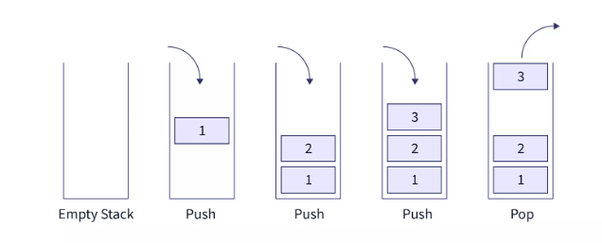Stacks in Golang
Stacks in Golang
In Golang, a stack is a linear data structure that works on the Last-In-First-Out (LIFO) principle which means that the element which is pushed in the stack in last will be popped out first.
In general stacks has 2 operations_
- Push: Adds an element to the top of the stack.
- Pop: Removes and returns the element from the top of the stack.
But we can also implement_
- Peek (or Top): Returns the element from the top of the stack without removing it.
- isEmpty: Checks if the stack is empty.
- Size (or Length): Returns the number of elements currently in the stack.
Implementation of Stack in Golang_
1
2
3
4
5
6
7
8
9
10
11
12
13
14
15
16
17
18
19
20
21
22
23
24
25
26
27
28
29
30
31
32
33
34
35
36
37
38
39
40
41
42
43
44
45
46
47
48
49
50
51
52
53
54
55
56
57
58
59
60
61
62
63
64
65
66
package main
import "fmt"
type stack struct {
items []interface{}
}
func (s *stack) Push(item interface{}) {
s.items = append(s.items, item)
}
func (s *stack) Pop() interface{} {
if len(s.items) == 0 {
return nil
}
index := len(s.items) - 1
item := s.items[index]
s.items = s.items[:index]
return item
}
func (s *stack) Peek() interface{} {
if len(s.items) == 0 {
return nil
}
return s.items[len(s.items)-1]
}
func (s *stack) IsEmpty() bool {
return len(s.items) == 0
}
func (s *stack) Print() {
fmt.Println("Stack:")
for _, item := range s.items {
fmt.Printf("%d->", item)
}
fmt.Println("\n")
}
func (s *stack) Length() int {
return len(s.items)
}
func main() {
stack := stack{}
stack.Push(1)
stack.Push(2)
stack.Push(3)
stack.Print()
ln := stack.Length()
fmt.Println("Length:", ln)
fmt.Println("\n")
fmt.Println("Peek:", stack.Peek())
fmt.Println("Pop:", stack.Pop())
fmt.Println("Pop:", stack.Pop())
fmt.Println("Pop:", stack.Pop())
fmt.Println("Is empty?", stack.IsEmpty())
}
Output
1
2
3
4
5
6
7
8
9
10
11
Stack:
1->2->3->
Length: 3
Peek: 3
Pop: 3
Pop: 2
Pop: 1
Is empty? true
This post is licensed under CC BY 4.0 by the author.
